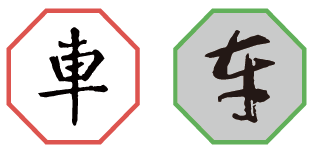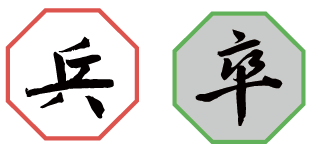|
Janggi is a Korean chess variant derived from an earlier form of Xiangqi (“Chinese chess”). There are many similarities with Xiangqi such as the starting positions and board layout, but Janggi has many of its own Korean innovations. |
Equipment
The board is composed of 9 vertical files and 10 horizontal rows with the pieces being played on the intersections. The sides are either green or red with green making the first move. The red pieces are labeled with traditional Chinese characters (Hanja). Their green piece counterparts are labeled in a semi-cursive script. On each side of the board against the back edge is a palace, which is 3 by 3 lines (9 positions) with four diagonal lines that extend outward from the center forming an “X” shape.
Arrangement
The starting positions of the pieces are arranged as shown below.

Pieces
  General, “Janggun”These pieces are equivalent to kings in international chess. The general starts the game at the central intersection of the palace and may move one space at a time to any of the 9 positions within the palace, following the lines marked on the board. The general cannot leave the palace. The game is lost when the general is checkmated. Generals may not face each other unobstructed by another piece with one exception, described later on. |
|
  Guards, “Sa”These are the king’s counselors and guard the king within the palace. They move exactly the same as the king and are confined within the palace.
|
|
  Horses, “Ma”Horses move similarly to the knight in international chess. They move one point in any direction, followed by one point diagonally outward. It cannot move in a direction where there is a piece blocking it along the path of movement. |
|
  Elephants, “Sang”Elephants move one point in any direction, followed by two points diagonally outward. It cannot move in a direction where there is a piece blocking it along the path of movement. |
|
  Chariots, “Cha”Chariots move similarly to the rooks in international chess. They move as many points as they wish in any direction horizontally or vertically. They cannot jump over pieces in their path. Within the palace, they can move along the diagonal lines. |
|
  Cannons, “Po”Cannons move by jumping another piece horizontally or vertically. They can jump over any distance provided there is exactly one piece anywhere between the original position and the target. However, they may not jump over another cannon (friend or foe) and may not capture an opponent’s cannon. Additionally, cannons may not make the first move. Within the palace, a cannon may jump along the diagonal lines (this can only occur if the cannon is in a corner of the palace). |
|
 
 Soldier, “Byeong” (red) / “Jol” (green)Soldiers move one point either forward or sideways. Once they reach the end of the board they can only move sideways. Within a palace, they can move forward along the diagonal lines.
|
Playing
The more experienced player conceals a soldier from each side in their hands and the other player chooses one of those hands. The player plays side of the chosen hand. Red places his pieces first, and then green places the other pieces. Each player can choose to switch the places of their horse and elephant on either side of the guards. After the pieces are placed green moves first.
Each side alternates, moving one piece in each turn. Pieces capture by using their normal moves and landing on a point occupied by an enemy piece.
A player may decide to pass if he has no safe or desirable move. This is done by turning over the general.
Ending the Game
Win
Victory is achieved by checkmating the opposing general. That occurs when the opponent’s general is left with no option but to be captured in the next move.
Draw
If a player moves a general to face another general across the board with no pieces in between (called bikjang), that player forfeits all possibility of winning the game. Even if later this player checkmates the second player, he can only hope to achieve a draw. The second player can either call a draw or move their general into a position where it is not facing the other’s general. The first player can bikjang more than once.
A player may use a general to defend an attacking piece in the enemy’s palace by moving his general into the same line of the attacking piece. By doing this the second player cannot capture the attacking piece without bikjang. If a player that uses their general in this way, to defend a piece that is in the second player’s palace giving checkmate, the game is considered to be a draw, not a win.
If a player forces continual repetition of the same moves and does not wish to continue, the game is declared a draw.
If it is agreed by both players that there are no more remaining possibilities for either to win the game, then a draw is declared.
© 2024 Yellow Mountain Imports, Inc.



